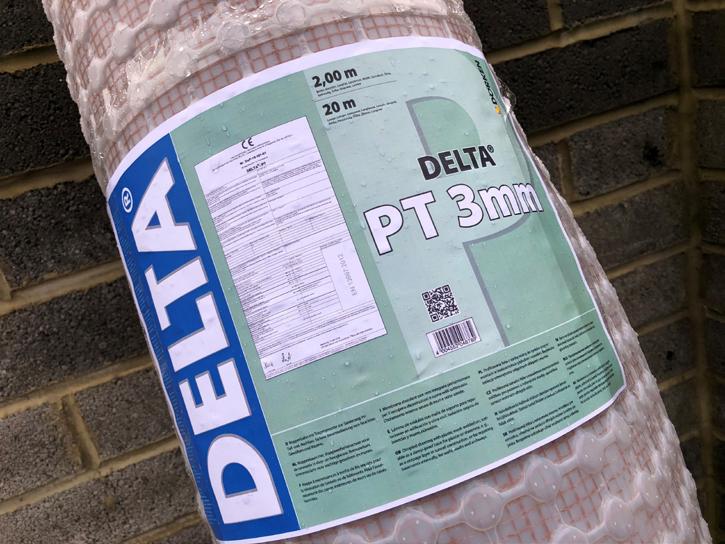
22 minute read
Sustainability
sustainability Quality in Construction - New product Development from Leaders in the Waterproofing Industry, Delta Membranes
Delta Membrane Systems Limited lead the field in innovations within the waterproofing sector with the launch of the new Delta PT 3mm Membrane.
Advertisement
D
elta PT 3mm Membrane has been developed specifically for addressing the issues of damp and contaminated walls, or where fast reinstatement of wall finishes is required after chemical damp proof injection.
Delta PT 3mm a High-Density Polyethylene (HDPE) low profile studded membrane with a heat welded polypropylene mesh provides a key for plasters, renders and dab fixing of plasterboards.
Air-gap membranes are particularly useful in projects that require waterproofing, damp proofing or a barrier against contamination, especially in barn conversion projects. Air gap membranes allow for the immediate reinstatement of plastered finishes following treatment.
Our Delta PT 3mm membrane can be used in a variety of ways, are easy to apply and offer a long-term protection to buildings and structures.
Kevin Dodds, Director said “Achieving sustainability in manufacturing requires a comprehensive view spanning not just the product and the manufacturing processes, but also the entire supply chain, including product lifespan. We recognise the need to provide leadership, promote quality and add value in all aspects of construction especially the waterproofing sector. We shall continue to invest in technologies and to lead the field.”
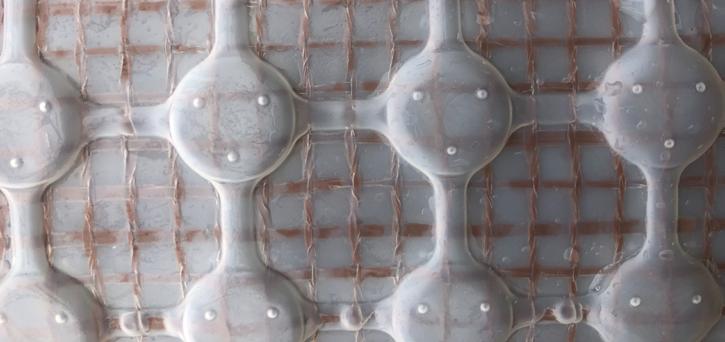

We specialise in solutions, from the smallest domestic project to high-end residential developments, commercial structures and civil projects which can be tailored to even the most challenging environment – above or below ground.
We consider the entire project process from concept to completion to the very finest of detail and can provide solutions for all project requirements.
Delta has developed a reputation for offering the best technical and customer support for waterproofing and damp proofing systems in the country.
Our technical team offer extensive expertise covering a broad range of specialist systems from concept to installation with troubleshooting and every other step along the way – contact us today on 01992 523 523 or email: info@deltamembranes.com.

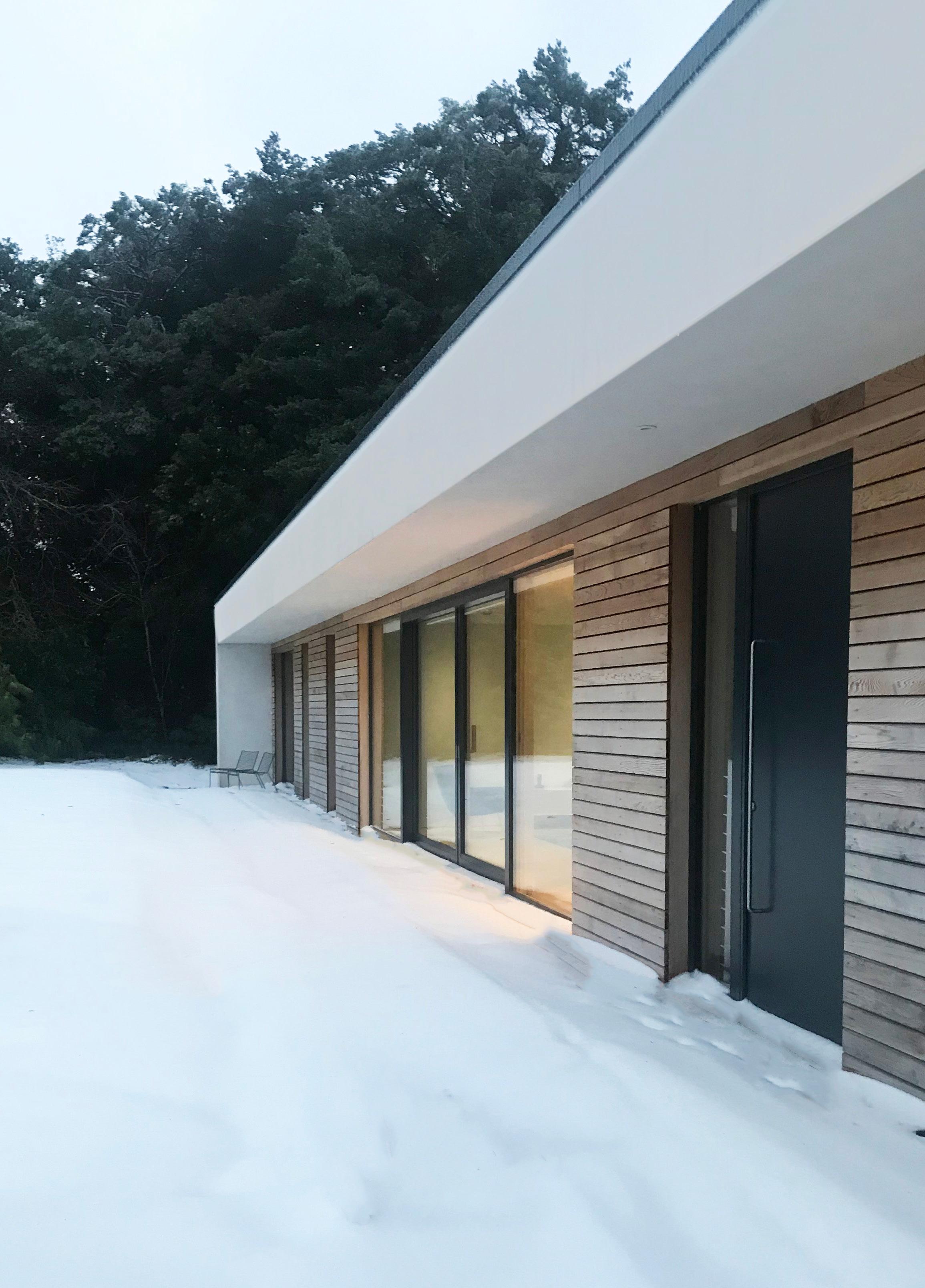

Sustainability WHAT IS SUSTAINABILITY?
The most commonly accepted definition of ‘Sustainability’ was made in 1987 when referring to future world development: ‘Sustainable development is ‘development that meets the needs of the present without compromising the ability of future generations to meet their own needs’. The concept of ‘Sustainability’ in practice is a broad church within which a number of social, economic and environmental issues are included.
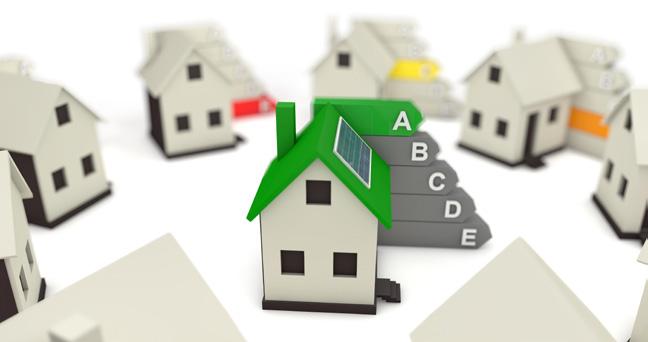
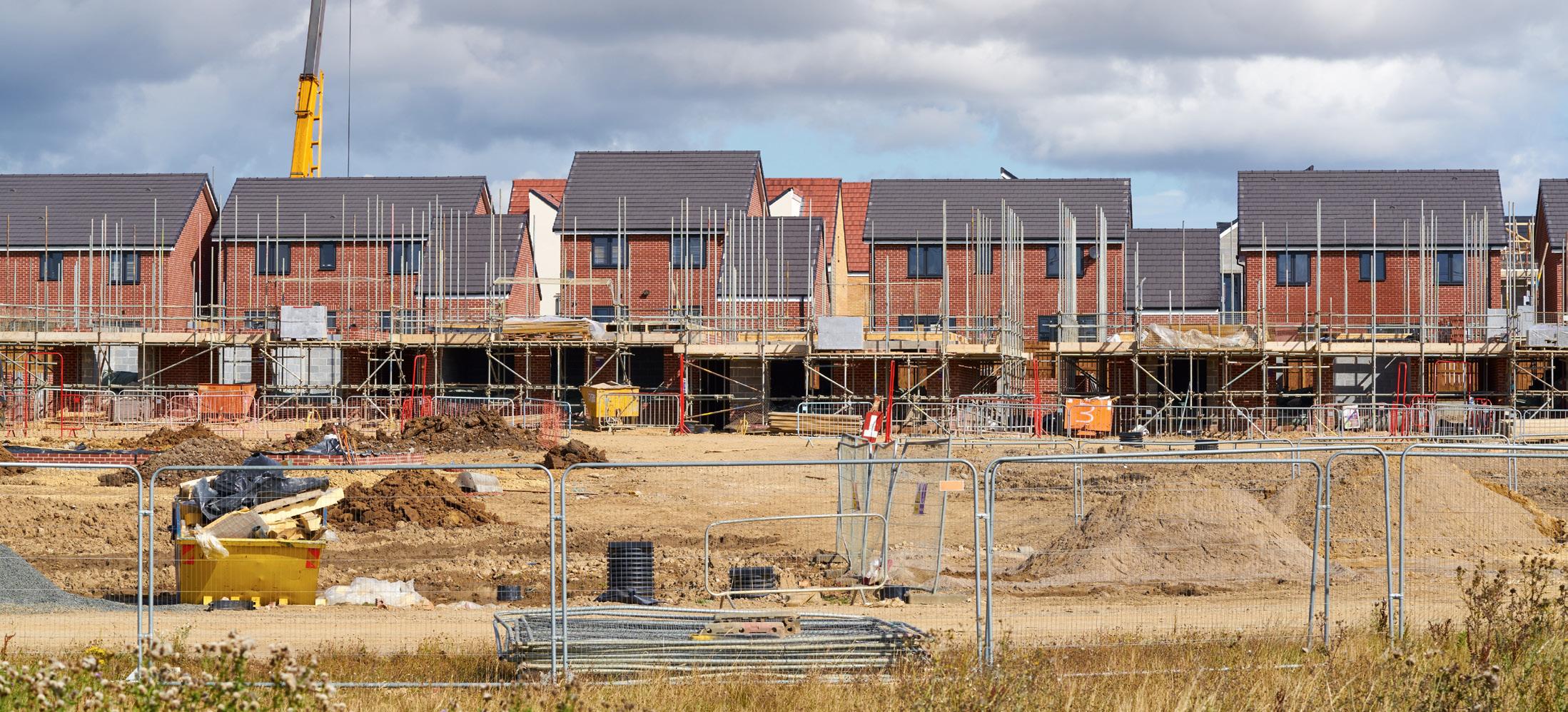
T
he building industry is usually responsible for around 10% of the UK economy and so represents a significant impact on areas of sustainability. The industry’s key zones of accountability are: Global warming gases from the energy it uses; The quantity of material resources it extracts from the earth; The environmental damage caused by material extraction, processing and construction; And the damage to health caused throughout the extraction, manufacture, use and final disposal of building materials.
HOW DOES THE BUILDING INDUSTRY ACHIEVE HIGHER LEVELS OF SUSTAINABILITY?
The industry can be more sustainable by adopting better principles and practices in the way it designs and constructs buildings. The way we design and build using the principles of ‘Green Building ‘can make a significant contribution, not only to reducing our collective impact on the environment but also to our health and wellbeing in the places we work and the homes we live in.
But….
Like many other large industries, construction is very slow to change. Economically, the industry is notoriously volatile, so it’s no surprise that change is seldom welcome or implemented. Most change is legislation-led through the Building Regulations and industryrelated initiatives such as BREEAM; but some change is thanks to individuals and companies taking responsibility for reducing their own environmental impacts.
SUSTAINABILITY, QUALITY AND SELF BUILD
The core of the construction industry is the ‘volume’ house-building sector. So critical is the role of the dozen or so companies that make up this group, that their economic role in the GDP (Gross Domestic Product), is regularly cited in economic reporting as the ‘weather vane’ of all industry. Key to their success is their efficiency of production. They buy materials and erect and sell homes on an industrial basis that maximises profits. That they manage to do this, whilst actually selling arguably poorly performing, indifferently constructed houses with abysmal space standards, is thanks to a well-oiled marketing machine that consistently succeeds at selling a premium on image, location and affordability. Notably, when the national economic output is bleak, so is that of the builders, who stop building until recovery. This chronic ‘boom and bust’ approach to housing is one of the reasons that the UK fails to meet the need for more homes.
In stark contrast to the anonymity and indifference of industry-produced housing, the self-build/custom build sector delivers for its members, well-built, wellperforming, high quality and spacious homes. Increasingly their houses are made from materials and designs that put people, their health and their future at the centre of the process.
There are between 10 - 20,000 self-builds in the UK every year. This is less than 1015% of all the homes built annually but may constitute as much as one-third of
new detached homes - this compares with 60% in Germany and 80% in Austria where self-build is the norm.
Despite their number, self-builders have and continue to make significant contributions to advances in house design and technology. In particular, in recent years, they have been responsible for the dramatic uptake of ‘Green’ features such as renewable energy and low environmental impact building systems. Outside of the self-build market, these are features that take several years to filter through to commercial housing developments.
There is many a volume house builder who looks upon his self-build cousin with envy. Shorn of the profit motive, but instead equipped with a will to build exactly for his/ her needs, the self-builder is at liberty to choose the type of construction and the materials that the building is made from.
In particular, the self-builder is uniquely enabled to choose freely from the wealth of materials now appearing on the market that are not only of very high quality but also representative of a quickly growing market in the UK for ‘sustainable’ and healthy ‘Green’ products.
‘FABRIC FIRST’
As part of the UK government’s first initiative in 2006 to tackle climate change, it published a voluntary code requiring new homes to add renewable energy devices to
the buildings. That it kicked off thousands of new businesses dealing in the installation of wind turbines, heat pumps and solar panels was probably no bad thing, but it was responsible for sending house builders off in the wrong direction.
Critics soon pointed out that the adding of energy-generating technology was usually doing not much more than covering for the poorly performing buildings they were attached to. The analogy to the policy was that of a leaking bucket of water: to keep the bucket full, it was necessary to keep pouring water into it - rather than fix the leaks themselves. The code didn’t change and was eventually eclipsed and abandoned. Instead, building designers and developers worked towards design standards of their own adoption. The most well-known standard, imported from Germany, is the Passivhaus standard which ensures that the way a house is built will deliver a heating requirement of no more than 15 kWh/m2/yr. This very low figure is achieved by careful design and the building fabric alone. For many already built Passivhaus homes, their heating systems have become largely redundant.
This emerging (in the UK) methodology of designing buildings to reduce their energy usage through building technology rather than adding renewable energy systems is known as ‘Fabric first’.
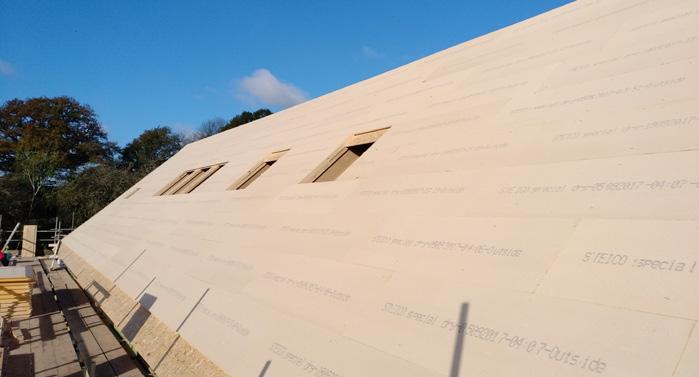
CHARACTERISTICS OF A ‘FABRIC FIRST’ APPROACH IS:
High performance and high quantities of insulation.
Maximum levels of air-tightness.
Use of heat given off by the occupants and their cooking and electronic devices to help the heat the spaces.
Optimisation of natural ventilation.
Optimisation of solar gain through appropriately located windows.
Sometimes using the thermal mass of the building to absorb excess heat.
In addition to high degrees of energy efficiency, the ‘Fabric first’ method provides a comfortable environment that makes few demands of the building’s occupants. Where renewable technologies place the reliance on the occupier to operate the sometimes complicated controls, a well-built energy efficient building has already done all the work for them.
WHAT TO LOOK FOR WHEN CHOOSING ‘GREEN’ BUILDING MATERIALS
‘Green’ building materials are products that have a lesser environmental impact than other materials that might be used for the same ‘job’ in the building. Apart from environmental preferences, Green materials are also usually associated with high levels of performance and safe user-friendliness. on the environment. Those that do vary from severe to mild and to sort one from the other it’s useful to consult the GreenSpec website which provides information about the environmental impacts of materials at www.greenspec.co.uk
There are usually plenty of alternatives, but the golden rule is to ensure that the products eventually selected can do the job demanded of them in a way equal to or better than materials they’re replacing.
It is notoriously difficult to clearly identify materials with a lesser overall environmental impact. Experts can take a lot of time in examining and assessing the potentially wide range of environmental properties contained within even a single building product.
However, when specifying an appropriate product or material, these are some of the key low impact and beneficial aspects to look for:
• Products that perform well and are easy to build with • Materials made from renewable crops such as timber, wool or hemp. • Products manufactured from abundant resources such as lime, clay or rock. • Products which minimise the use of fossil-fuel energy in the manufacturing process (embodied carbon). • Materials which, as a part of their function, improve a building’s energy efficiency. • Manufacturing processes that don’t pollute. • Materials that are safe to use and dispose of or recycle. • Products containing recycled materials.
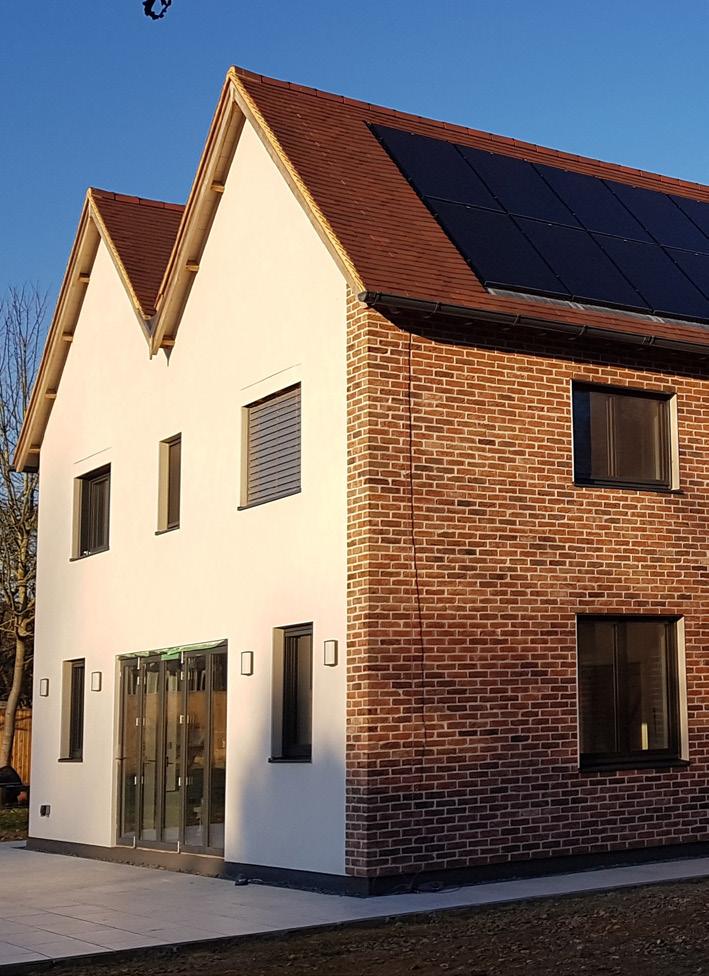

THE HEALTHY HOME
Whether it be sleeping, eating, relaxing or working, we spend most of our day inhabiting our homes. Because of that time in a familiar space, we become adept at managing its environment. We are familiar with controlling lighting, heating and ventilation through simply throwing a switch or opening a window. Though the technologies have changed, the basic control actions are as they have been for generations.
Though the basic provision of light and warmth is unchanged, the contents of the air we breathe has altered over the last 50 years. We could now be dealing with a raft of possible toxins that if not sufficiently designed and built to avoid, could lead to serious health issues. Perhaps not surprisingly, these changes have been brought about through the way we build and the materials we use.
The principal drivers behind the need to improve the efficiency of our homes began with the oil crisis in the 1970s since when we have set out to reduce our dependence on fossil fuels. In the last decade, climate change has been added to the agenda. The combination of the two has had an aggrandising effect on building regulations and the techniques we use to design and build.
For our homes, the two main methods of addressing energy conservation are insulation and airtightness. We are used to using insulation in our walls and roofs, but now house builders have to learn the techniques of sealing openings in the building fabric to prevent warm air leaking out.
The result of sealing buildings could be that for many of us opening a window or just relying on the leaky nature of our buildings might not be enough to deal with the smelly, oxygen-depleted or damp air caused by everyday living.
Air contamination from materials we use in our homes is relatively new and owes its occurrence to the growth of synthetic materials. Ordinary products such as paints, floor finishes, timber-laminates, furniture, synthetic textiles, plastics and foams can emit a chemical cocktail including volatile organic compounds (VOC’s) like formaldehyde, xylene, isobutylaldehyde, and organochlorides, aldehydes and phenols. Emissions from materials are known as ‘offgassing’ and can result in higher, more toxic concentrations without suitable ventilation. Sadly the most familiar aspect of an unhealthy building, damp caused by condensation, continues to blight modern housing. Most buildings show the effects of condensation to some degree – from water appearing on the glass of cold windows through to damaging mould found on walls and ceilings.
Asthma linked to inhabiting in these unhealthy conditions is on the increase, caused by damp and mould, house dust mites and chemicals in carpets and flooring materials.
The direct solution to damp air is adequate ventilation, but there is also a technique of building that has gained traction in recent years. The ‘Breathing wall’ is one that uses ‘hydroscopic’ materials and membranes together to allow moisture to pass from the interior through the wall to the outside air.
SUMMING-UP, IMPROVING INDOOR AIR QUALITY (IAQ) IS ACHIEVED BY:
Designing a ventilation strategy that can include simply opening windows through to providing mechanical ventilation. Above all, whatever strategy is chosen, it is vital that it is easy to understand and operate by the user.
Considering the use of ‘breathing walls’ that help migrate internal dampness through to the outside.
Avoiding materials that are suspected of offgassing toxins.
Thinking holistically about combining techniques of reducing humidity and pollution and toxins - adding up to a whole that is more effective than the sum of its parts.
Using Green building materials from suppliers like Ecomerchant.
… and not forgetting the potential of indoor plants to absorb toxins and carbon dioxide
TOP TIPS FOR GOING GREEN
Whether planning to build new from scratch or refurbishing, this is the time to incorporate sustainability into your project through design and the careful choice of materials; Getting it right will insulate you against spiralling energy bills, provide a durable long-lasting healthy home and leave a lighter footprint on the earth.
The building industry generally acknowledges that self-builders build better quality buildings; In building their own homes, they are often keen to explore proven and beneficial systems that would not necessarily be part of a developer or volume house builder’s package.
SO WHAT ARE THE KEY ASPECTS OF BUILDING TO GREEN STANDARDS?
Using enough insulation - most buildings are built with too little
The more insulation you incorporate into the walls, roofs and floors of your home, the more heat it will retain. Insulation is probably the main element to get right at the start, so it’s important to ensure the appropriate materials are used in the right way and in sufficient quantity. Fewer gaps in your home’s structural envelope mean less heat lost. Good air tightness maximises the efficiency of the insulation and reduces fuel bills. With airtightness, ventilation is essential and needs careful design. Ventilation can be passive, mechanical or both.
Use the buildings thermal mass to best effect
The idea of thermal-mass is difficult to understand for most of us – so it’s wise to get advice before using it. Materials such as stone, brick, terracotta and concrete can provide ‘thermal mass’. Used with care, it can help moderate the internal environment throughout the day by absorbing excess heat from the sun or other sources and then releasing the heat back into the interior during darkness.
Design for overheating.
Increasingly hot summers are a climate feature we all need to design for. Use wood fibre insulation, particularly in rooms in the roof, but also in walls to slow down heat transfer from the outside. Think about using shading for windows exposed to the sun in summer, but make sure they’re not shaded in winter.
Make the best use of natural light
Maximising the amount of natural light in your home reduces the need for artificial lighting. Windows are an essential element of the building’s performance. Modern windows can be very efficient with whole window U values as low as 0.8W/m2K. ‘Solar gain’ can help heat the home.
Choose Green materials
Green materials have a range of features and benefits not usually present in synthetic materials; A majority are less polluting, safer and recyclable. Most too can significantly out-perform synthetic oil-based products in aspects that are becoming more important as the UK warms-up.
Structural systems - choose your system early in the design process
Most construction techniques can be adapted to meet high levels of energy efficiency, but some lend themselves more immediately to hitting the highest standards. This is where you will come across the expression ‘Fabric first ‘where the building contributes significantly to overall energy efficiency.
Some of the most popular systems for self-builders are:
• Timber frame with timber, brick or render cladding • Monolithic clay blocks and render • Brick and block cavity walling • Cross-laminated timber (CLT) and cladding
Deploy renewable technologies only after your shell design is complete
Self-builders have led the way in terms of adopting renewable technologies to best effect, the golden rule here is to design the building to do the work, then match your energy needs to that level.
Thanks to our authors Sandy Patience & Will Kirkman: Sandy is an architect, journalist and speaker. He is the editor of GreenSpec at www.greenspec.co.uk - a site dedicated to delivering information about the design and building of Green Buildings. Will is a co-owner of Ecomerchant (a sustainable builder’s merchant), www.ecomerchant.co.uk writer and speaker and has been involved in promoting green construction for over 25 years. Call Ecomerchant on 01793 847 444 or email info@ecomerchant.co.uk

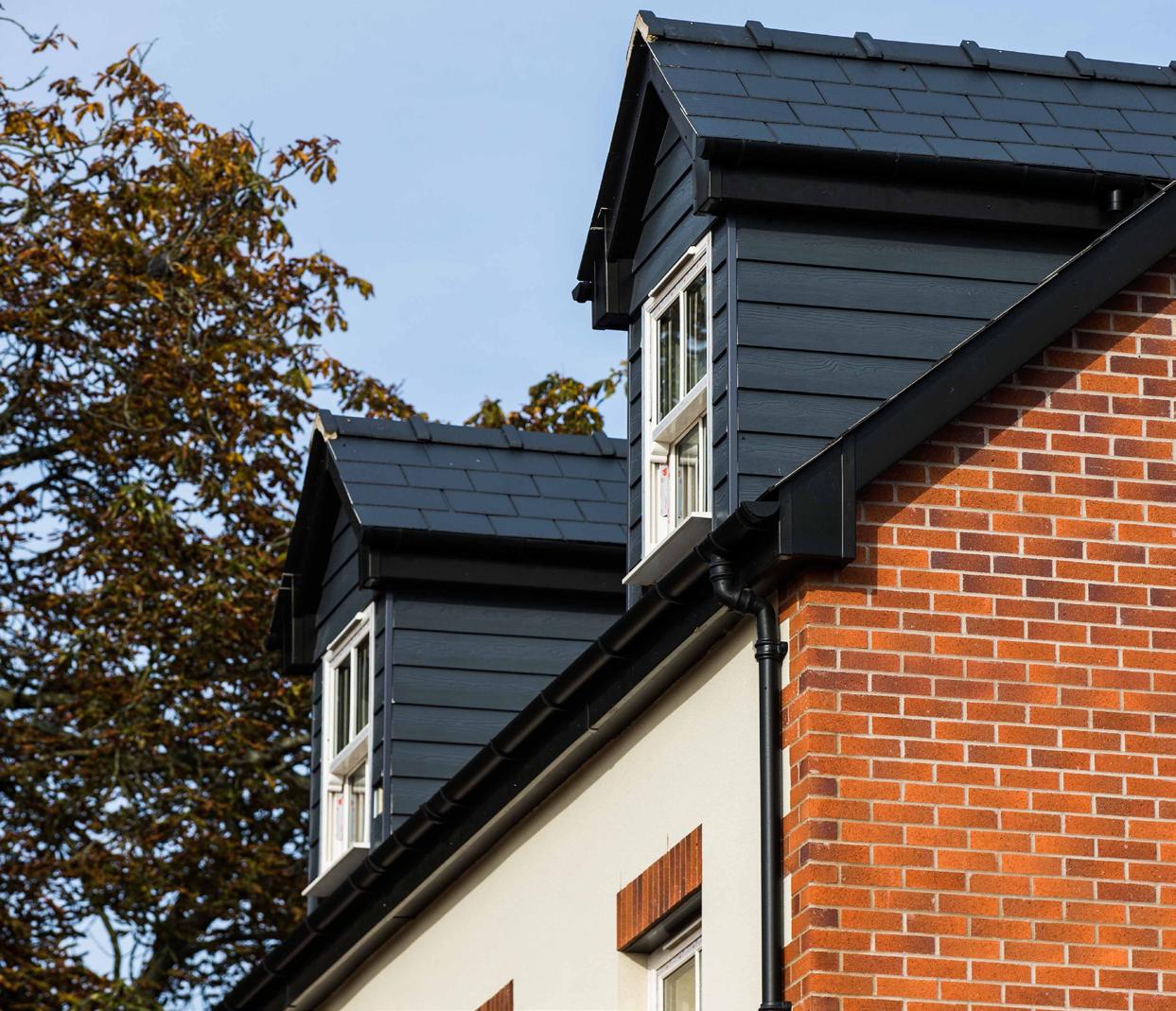
COMPLETE PACKAGE OF BRETT MARTIN DRAINAGE SOLUTIONS SPECIFIED FOR FOREST OF DEAN DEVELOPMENT
High performance, reliable and easy-to-install rainwater and underground drainage systems from Brett Martin Plumbing and Drainage have been specified for a new housing development in Tutshill, Gloucestershire, the village where JK Rowling spent her childhood and inspired many Harry Potter books. L
ocated in the stunning Forest of Dean, on the banks of the River Wye near Chepstow, Birch Grove includes 45 new three, four and five-bedroom family homes all built to a high-specification for discerning buyers. In order to achieve the desired performance and aesthetics, housebuilder ButlerWall Homes chose a comprehensive and cost-effective range of rainwater and drainage systems which met their demands for quality, durability, low maintenance and ease-of-installation.
The specification across these family homes included Brett Martin’s Cast Iron Style Cascade Rainwater System comprising a 115mm Half Round Gutter and 68mm Round Downpipe in classic black. Significantly lighter than cast iron rainwater systems, Cascade is much quicker, easier and safer to install at height, helping to offer the developer huge savings in terms of on-site installation costs. The system also features external fixing lugs designed to facilitate the use of power tools, further speeding up installation.
In addition to the popular classic black colour specified on the Birch Grove Development, Cascade is also available in a further seven heritage colours including Anthracite Grey, Oxford Blue,

Chartwell Green, Olive Green, Graphite Grey, Sandstone and Porcelain White - all of which cater to the subtle nuances of local vernacular architecture. The complete colour range delivers the traditional appearance of Cast Iron with the convenience of modern plastic materials. Cascade is also UV stabilised for a maintenance-free system that will stay looking great and working well for years, and comes with a 10-year guarantee.
The development also saw the installation of Brett Martin’s Adoptable Inspection Chamber Assemblies available in 315mm and 450mm diameters. Offering superior structural strength, enhanced loading capacity for long term serviceability, these cost-effective lightweight chamber assemblies are easy to install due to watertight push-fit assemblies and a solid, stable connection using the additional connection points in the form of lugs featured on both base and riser.
Brett Martin’s high-performance adoptable chamber assemblies carry the BSI Kitemark KM 635998, are tested to EN13598-1 and satisfy both the requirements of Sewers for Adoption (SfA7) and Building Regulations.
Using a reputable manufacturer such as Brett Martin offers far more than the quality and versatility of the product itself – they provide superior technical support, detailed installation instructions and maintenance guidelines to ensure rainwater systems perform exactly as promised.
With this fabulous new village development now complete, Brett Martin’s Cascade Cast Iron Style Rainwater System and a range of underground drainage solutions have met the aesthetic and performance requirements of the developer whilst ensuring a fast, efficient and economical installation.

To find out more about Brett Martin Plumbing and Drainage visit: www.brettmartin.com
External works & landscaping Bring the glamour of Chelsea to your garden with the ultimate in contemporary features and screens from Kangular
Adding a stylish, architectural look to gardens that’s worthy of the Chelsea Flower Show or a Grand Designs makeover has never been easier, thanks to Kangular, the ultimate line-up of affordable contemporary features and structural screens that create instant impact.
K
angular empowers the nation’s gardeners and homeimprovers to quickly achieve a sophisticated, designer look: a piece of instant artwork in gardens that wouldn’t look out of place in a gallery, but at a fraction of the cost.
The leading range of Designer Features encompass stainless steel and wooden slatted structures in Fan, Wave and Pear shapes with heights ranging from one to three metres, as well as a range of elegant Structural Screens and Wheelie Bin Enclosures. Shapes can be modified with Kangular’s clever, adjustable slot and wedge fixing.

Unique, eye-catching focal points Kangular’s designer range provides stunning focal points for gardens, borders and driveways, while privacy screens shield gardens from overlooking properties or neighbours – perfect for hot tubs, swimming pools and al-fresco dining areas, as well as enclosing gardens from passing pedestrians or the din of traffic noise. Not only will screens add architectural structure to garden borders or increase the height of existing walls, but they will stylishly enclose driveways, shielding cars, caravans or motorhomes from view.
Owners can ramp-up the wow factor of Kangular structures with uplighters or downlighters that add a new dimension to gardens after dark, while there’s even the option of wine glass holders to safely store drinks. Kangular screens offer a fashionable way to quickly screen-off unsightly areas of gardens – from disguising ugly wheelie bins, compost heaps, water butts and sheds to hiding eyesore utility items such as oil tanks and air conditioning units.
Kangular’s Paul Raven said: “To pay a designer and builder to create and install a structure with the high-end look that Kangular offers would rack-up a bill running into many thousands of pounds, not to mention the time and hassle that’s all too often associated with tracking down reliable, trustworthy tradesmen who will turn up on time and complete the job. In contrast, Kangular structures are quick and easy for gardeners to install themselves, while the simple process can be completed in just two hours, creating instant impact outdoors.”
Patented Kangular systems offer countless practical and visual benefits for gardenowners. As well as creating sight lines and partitions, the contemporary designs come into their own for framing a planted area, or for shielding delicate plants from strong or drying winds. Kangular is rapidly becoming the go-to solution for injecting adventure into bland spaces by dividing gardens up into creative outdoor rooms.

Personalised to suit your style Kangular can also be treated as a blank canvass to create shapes that suit varying styles of outdoor living. Screens can be transformed into a Christmas tree design for the festive season, or an eggshape at Easter, for example. A bespoke design service offers the highest levels of customisation, while Kangular can provide Laser marking, enabling special messages to be engraved into structures to help celebrate a special occasion.
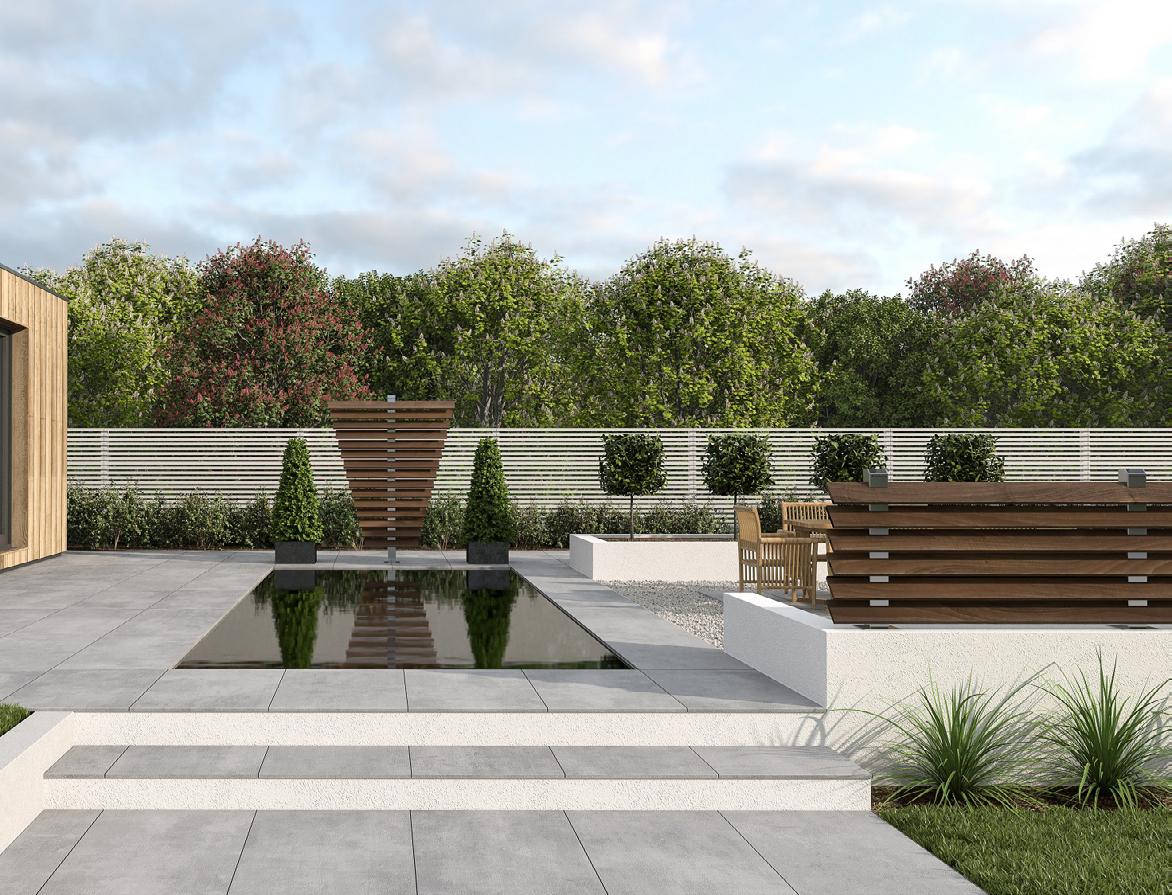
In line with current trends for sustainability in gardens, Kangular structures are both eco-friendly and British-made. The hardwood slats that form the backbone of screens are FSC or EUTR-regulated, while structures are 100% recyclable, too.
For instant transformations, Kangular features are quick and easy to erect, requiring only a spade, spirit level and a hammer – no nails, screws or glue fixings are needed – and for additional convenience, Kangular offers a home installation service, too.
Designed and built to last Kangular structures feature angled, slotted, high-quality stainless-steel columns, strengthened by a patented wedge system, resulting in a robust structure that’s capable of withstanding the worst that the weather throws at it. The Kangular patented column system is engineered using the latest laser tube cutting technology, while every part of the system has been designed to be aesthetically pleasing. Structures can be placed 1.8m apart and there is no requirement for planning permission. All Kangular features come with a five-year warranty and have a 20-year lifespan, while the Kangular column is warrantied for 10 years for additional peace of mind.
Prices for Kangular’s Designer Fan, Wave and Pear structures start at just £860 including VAT and delivery, while Sculptural Screens cost from as little as £460. Prices for screens that provide privacy around hot tubs and swim spas begin at £1,950. Kangular Wheelie Bin Enclosures are available in single, double and triple sizes, with prices starting at just £1,960.
Find out more All Kangular products can be purchased directly from www.kangular.com or email info@kangular.com to find out more. Installing the Kangular system is easy Each set comes with detailed, easyto-understand instructions, making installation a breeze. Just follow these three simple steps: (note: boltdown fixings are available, too)
1. Dig a hole to the correct depth. Around one third of the
Kangular upright should be buried.
2. Place the Kangular column into the hole, make sure it’s upright and level, then wait for the quick-drying cement to set.
3. Place the Kangular hardwood sets into the column, secure the slats with a Kangular wedge and your stunning new garden structure is complete





